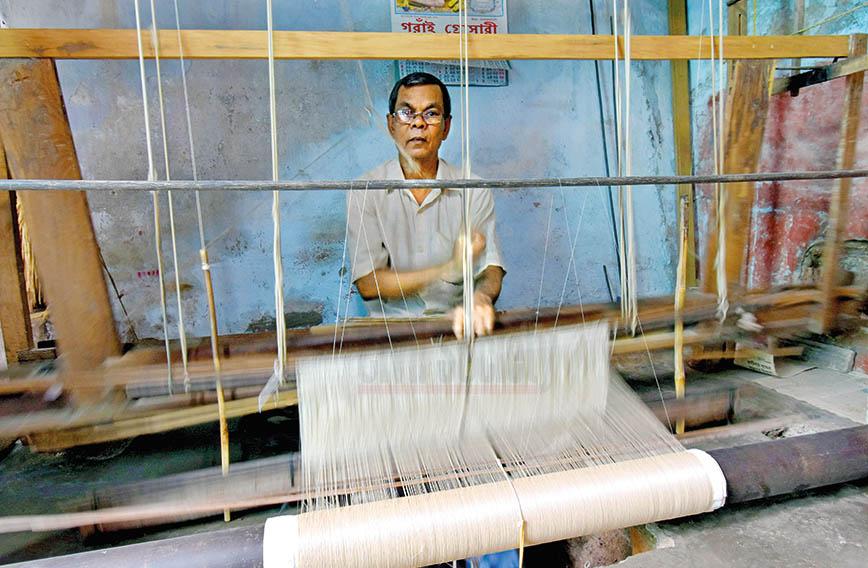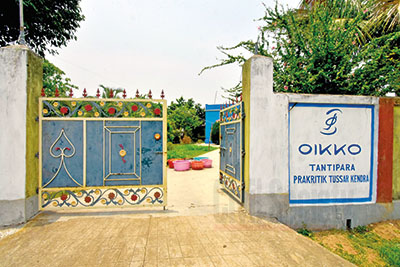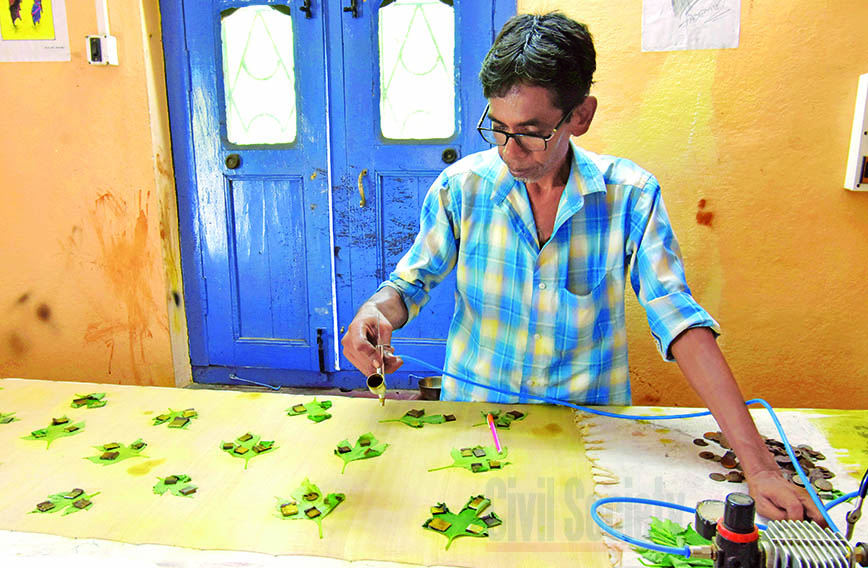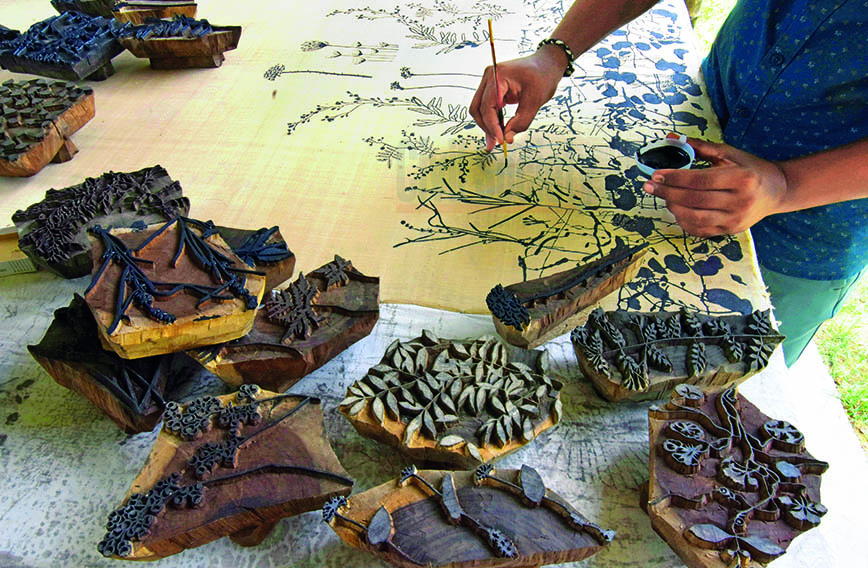
One of the weavers, Shyamsundar Dutta: ‘There was a time when Tantipara had 400 looms. Now there are barely 100’ | Civil Society picture/Ashoke Chakrabarty
A brand gets built in rural Bengal
Civil Society News, New Delhi
TANTIPARA is a small village in West Bengal, a few hours by train from Kolkata. Chances are you won’t ever be headed in its direction. But if you happen to come across skillfully woven and printed silk products under the name of Oikko in your city, remember they come from there.
Oikko has been popping up at crafts bazaars for the past couple of years, catching the attention of fashion scouts in search of designs and fabrics they can use. Most recently, Anita Dongre’s office at Global Desi, an iconic womenswear brand that melds traditional with modern, expressed interest in Oikko designs and a line of garments is perhaps on its way.
A fine dining restaurant in Chennai is also a potential customer — it wants its silk cushions with unique Oikko designs. You can get Oikko products in the Sasha store in Kolkata and the Amoli boutique in Santiniketan.
So, Tantipara has been quietly making its presence felt. The notice it is getting doesn’t come a day sooner than it needs to. The weavers of Tantipara have for long been recognized for their Tussar, the traditional name of the silk fabric they produce. But the past few decades haven’t been good for them.
Weavers in Tantipara have witnessed business dwindle in the face of changing markets, cheaper alternatives and the rising costs of raw materials. Younger people have also seen no future in weaving. As the bottom has dropped out of the local economy, villagers have had no option but to migrate in search of work — mostly opting for menial work on construction sites and so on. Some have gone to distant cities.
In the midst of such gloom and despair, Oikko has arrived as a ray of hope. It is the outcome of an effort by AHEAD Initiatives, an NGO that has worked with the weavers and women in the village to combine Tussar with distinctive designs and embroidery to create a brand. Oikko gives beautiful Tussar the composite appeal of a brand so that the weavers and the village of Tantipara itself can compete in a modern marketplace.
The value addition has been inventive. Oikko in Bengali means oneness and is an emblem of ecological balance. The colours used are natural dyes made from the flowers and fruits of the area. The images are from nature. All the natural colours they need are made by the people of the village with the exception of indigo which no longer grows there.
AHEAD Initiatives arrived in the village around 2016 to implement an after-school programme. It wasn’t then but is currently funded and partnered by iiINTERest of Denmark. They set out to address the problems of nutrition, environment and livelihoods. Soon it was clear that reviving weaving of Tussar and making it remunerative could be a game changer. The women had design and embroidery skills. The weavers were of course masters of their craft.
 |
| The Oikko centre | Civil Society picture/Ashoke Chakrabarty |
The NGO trained local people in natural dye-making and block printing. An innate local talent for embroidery and design has been helped to flower. But, above all, the initiative has helped Tantipara connect with the world and be recognized in markets it couldn’t earlier reach. Business is done in the name of the Tantipara Prakritik Tussar Kendra. A proper producer company is the next stage in this journey.
Tantipara is an example of how rural areas can flourish by reviving local skills and by making traditional forms of employment sustainable through identity building.
It is not an easy path to take. It is still very early days in Tantipara, even after eight years. AHEAD Initiatives has been working directly with just nine women for the creation of products even as it reaches out to some 200 others. Revenues, too, are as yet minuscule. There is as yet a lot of handholding that happens and so it is difficult to envisage when a local producer company will look after its own affairs entirely. Nevertheless, a beginning has been made.
Recalls Shyamsundar Dutta who belongs to an intergenerational family of Tussar weavers: “There was a time when Tantipara had 400 looms. Now there are about a hundred. The younger generation isn’t interested in weaving because it’s not financially sustainable for them. Raw materials are expensive. Thirty years ago, a bag of around 1,500 cocoons (Tussar silk is extracted from silkworms) was priced at Rs 65; now the same costs Rs 10,000. Moreover, it isn’t a one-person endeavour. One weaver is dependent on others to weave a single garment. So they migrate outside West Bengal because they can earn much more as labourers.”
Says Abeer Chakravarty, managing director of AHEAD Initiatives, “Our work has been directed at tackling and redressing food and nutrition security, providing contextually appropriate education following Gandhi and Tagore’s philosophy of education, and creating livelihood opportunities by optimizing the skillsets of communities.”
Forced migration, early marriage and some cases of trafficking are social problems that have plagued Tantipara and can be traced to the absence of sustainable livelihoods.
 Leaf motifs being embroidered on Tussar | Civil Society picture/Ashoke Chakrabarty
Leaf motifs being embroidered on Tussar | Civil Society picture/Ashoke Chakrabarty
Preserving the environment is also important and factored into the Oikko brand. Until eight years ago there was widespread use of chemical dyes. Now that the people of Tantipara have brought back the natural dyes they once used, they have put chemicals behind them.
Chakravarty used to be in advertising. He knows a thing or two about marketing. Now in his mid-sixties, he runs AHEAD with great passion. Connecting villages and cities and getting wholesome produce to consumers while making sure farmers earn decently has always been an area of interest for him. He once ran a small enterprise delivering organically grown fresh vegetables to people’s homes — this was decades before the current buzz over home delivery.
For Chakravarty, while communities make choices unique to themselves, when looked at together, they point to a single problem that threatens handicrafts across the country — fair access to markets.
“We have incredible artists who aren’t able to find a market and so are closing down or taking short-cuts to make their products such as using chemicals, or Chinese silk and Korean silk that are inferior to the silk that was woven for generations,” he says.
“Handwoven traditional sarees are being replaced by machine-made substitutes and weavers are compelled to work as masons in other cities. Handicrafts represent the intricately diverse creativity of rural India and in our not linking artisans to distributive networks and relinking their communities to the earth, as they were before, we are in danger of losing our cultural heritage,” he explains.
The After School project in Tantipara zeroed in on honing embroidery and returning to natural colours. Artisans have been working with mediums that include block printing, hand painting, tie-and-dye, and spray painting.
 Natural colours and designs inspired by nature | Civil Society picture/Ashoke Chakrabarty
Natural colours and designs inspired by nature | Civil Society picture/Ashoke Chakrabarty
Says one such artisan, Uttam Das: “When we used chemicals, the grass around our homes would be destroyed. The feel of material that is naturally coloured is different, lighter, and the inherent golden texture of Tussar is amplified.”
The collaboration with iiINTERest as a funding partner began in 2018. It was then that AHEAD Initiatives started its handicrafts project in the village. They researched natural dyeing and experimented with plants indigenous to Tantipara. Artisans in the village like Das say they have now become “all-rounders”, equally adroit at making colour and designing.
Their 10 core colours have been developed from madder roots, turmeric, tea, hibiscus, dadmari (emperor’s candlesticks), haritaki (myrobalan), onion, marigold, neem and palash (flame of the forest).
Experiments have extended to art-making techniques as well — they found that metallic facial spray guns used in salons could be adapted as spray painting devices for fabric as well.
Guided by Bodil Bitze Faber of iiINTERest, the artisans have internalized a design aesthetic that draws on their own natural environment. The goal was to design pieces that were both distinguishable from other Tussar products in the market and authentic to the sensibility of Tantipara.
They desist from cluttered designs and excessive embroidery, evolving a style that is elegant in its minimalism and simultaneous attention to detailing. In reimagining Tussar designs, they attract buyers who relate to the vision underlying the products and discover in their artistry contemporary appeal. Their products comprise sarees, stoles, scarves, bags and purses, cushion covers and table-runners.
In 2022, with the pandemic fading, they started exhibiting under the name of the Tantipara Prakritik Tussar Kendra and the Oikko brand name has followed.
Chakravarty adds: “While pure Tussar silk and natural dyes are key differentiators for Tantipara Prakritik Tussar Kendra and the designs are distinct, the Oikko brand story rests a lot on the ethos and values of the artisans. Oikko is a Bengali word (originally Aikyam in Sanskrit) which means harmony or oneness. Our brand, Oikko, is about harmony between soul, soil and society — arising from a belief in the interconnectedness of life.”
As a result, Oikko is careful about who it partners with commercially, choosing distributors who are in sync with their sustainability practices. Their products have been sold and exhibited by Kolkata’s Sasha (a store for and distributor of Indian handicrafts), they have also been invited to exhibitions at three Dastkar fairs (Delhi) and Nabanna (Santiniketan), and Amoli — a boutique in Santiniketan that spotlights Birbhum’s arts — sells their products.
Exhibitions have played a pivotal role in tapping potential supply chains because leading designers get to see their products, catalyzing enquiries and orders. It was through one such exhibition that the fine dining restaurant coming up in Chennai ordered cushions for their space from Oikko.
The growth of the project has been very natural. One thing led to the next and it wasn’t as though there was a grand plan. At first some products were being designed and made with Scandinavian designs when the skill of the local people became apparent. Chakravarty recalls taking a bunch of samples over to Sasha where the people were thrilled and emphatically suggested that Tantipara send its products to crafts fairs such as the one held by Dastkar in Delhi.
Says Chakravarty: “I told Bodil that we should go and show the products to some people. She had a nice bundle of these clothes and we went to Sujatha and Rupa at Sasha. They were just floored by what they saw. They called others and said, ‘Look at this incredible stuff they’re making.’ And what they found incredible was of course the designs but also the way embroidery and hand painting had been blended. It was very different. They said we must display in exhibitions and that they would call up Laila Tyabji. I said, ‘Look, we’re not ready to sell anything. We just want to show you some stuff.’ The beauty of it is that the whole thing developed organically. You know, it just flew.”
 A typical After School session | Civil Society picture/Ashoke Chakrabarty
A typical After School session | Civil Society picture/Ashoke Chakrabarty
Training continues to run concurrently for the artisans. Sasha has conducted sessions on costing and how to form a company, as has the Fair Trade Forum. The idea is to instil an understanding of self-reliance and self-sufficiency in the artisans.
Says Chakravarty: “We are here to facilitate. The objective is to create something that’s sustainable enough so that when we step out, they can carry on. We won’t be here forever and we can’t fund them forever.”
This sentiment is echoed by Bitze Faber: “It is very important that the young people who are working with it now find that this is their own, build their own future: we are just visitors on the way.”
Fostering self-sustainability is not at the cost of self-awareness and, perhaps more importantly, communal self-awareness. Elucidates Chakravarty: “Firstly, fashion is the second largest polluter in the world and we don’t want to add to that. Secondly, inspired by Tagore who so early on had recognized the need to rejuvenate Indian handicrafts, we drew on the skills that were ingrained in the community to reinvigorate what and how they were creating. Thirdly, we envisioned a product that was different and that gave higher returns. We don’t want to create a factory. Anyone we work with must respect artisans. Plus we want them to have fun making art and, at the same time, make a living out of it.”
The enjoyment is palpable, whether in the weekly After School classes where first- and second-line trainers are teaching embroidery to larger groups of women in the village (and they don’t mind if classes spill over) or in the block printing, hand painting and kantha work spaces where artisans design, stitch, paint and co-create colours together. Nothing is machine-made — not even the labels or the cotton bags in which Oikko products are put.
The pace is unrushed, the atmosphere is happy and a shared sense of pride and ownership percolates from the personal and communal coding in the nomenclature of the houses where they work — Amader Bari (Our House) and Neel Bari (Blue House) — to the manner in which they speak about their craft, at every unit of operation: “Being able to teach and being able to embroider pieces we sell is deeply satisfying,” asserts Shitala Mondal, who has been with the organization since 2018 and was one of their first After School trainers, teaching kantha embroidery. Further, she repurposes discarded synthetic cloth and cotton material to fashion doormats and pillowcases.
“I’m delighted that I could first learn and then teach others both within and outside Tantipara (they have, additionally, facilitated classes on embroidery in Purulia),” affirms Tuhina Kabiraj, a second-line trainer who has also been associated with the centre since 2018.
Bikash Dutta, who works with, among other units, block printing, embodies the spirit of the enterprise when he notes: “I value the variation in design that I’ve learned here along with the fact that what we do is always grounded in nature.”
And Uttam Mondal exemplifies the artisans Chakravarty spoke about, struggling to find professionally viable opportunities as artists. “I’ve loved painting since my childhood and used to teach children how to draw just because I liked it so much. But I had to give it up and start an electronics business to earn. AHEAD Initiatives gave me the chance to train in what I’m passionate about. Now I hardly have the time to open my shop,” he smiles as he deftly shifts between block printing and hand painting.
Comments
Currently there are no Comments. Be first to write a comment!




